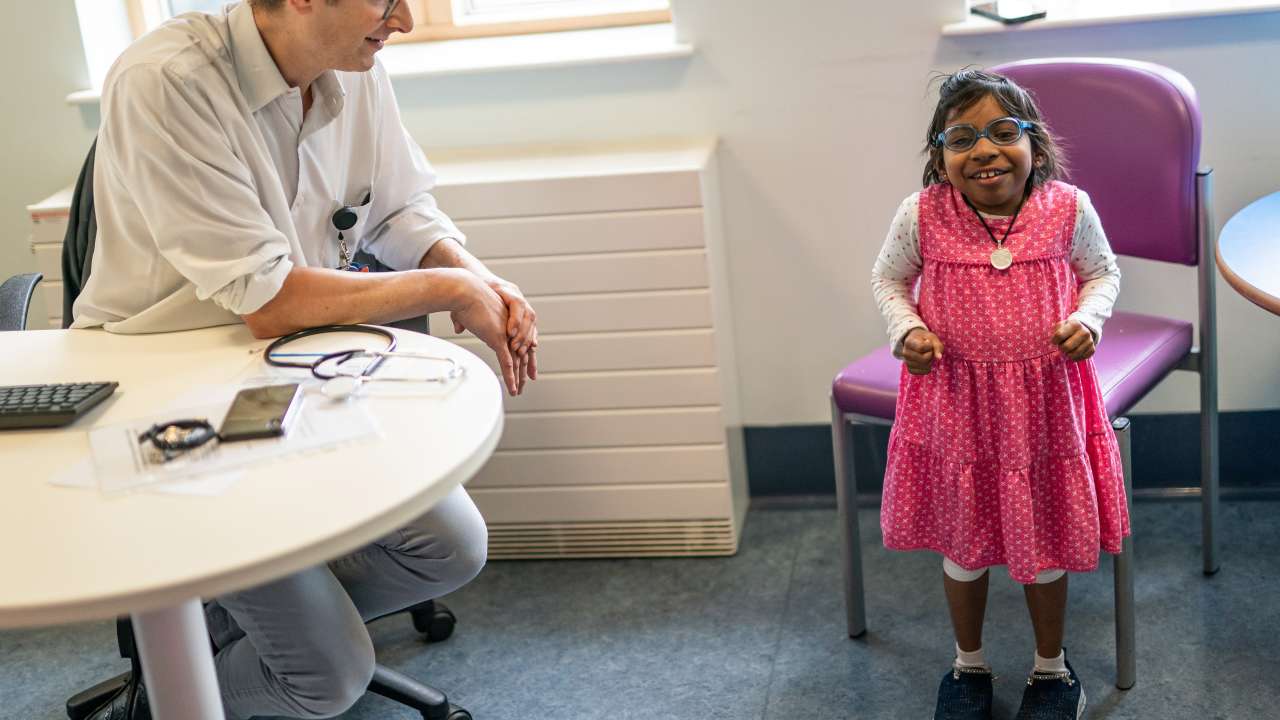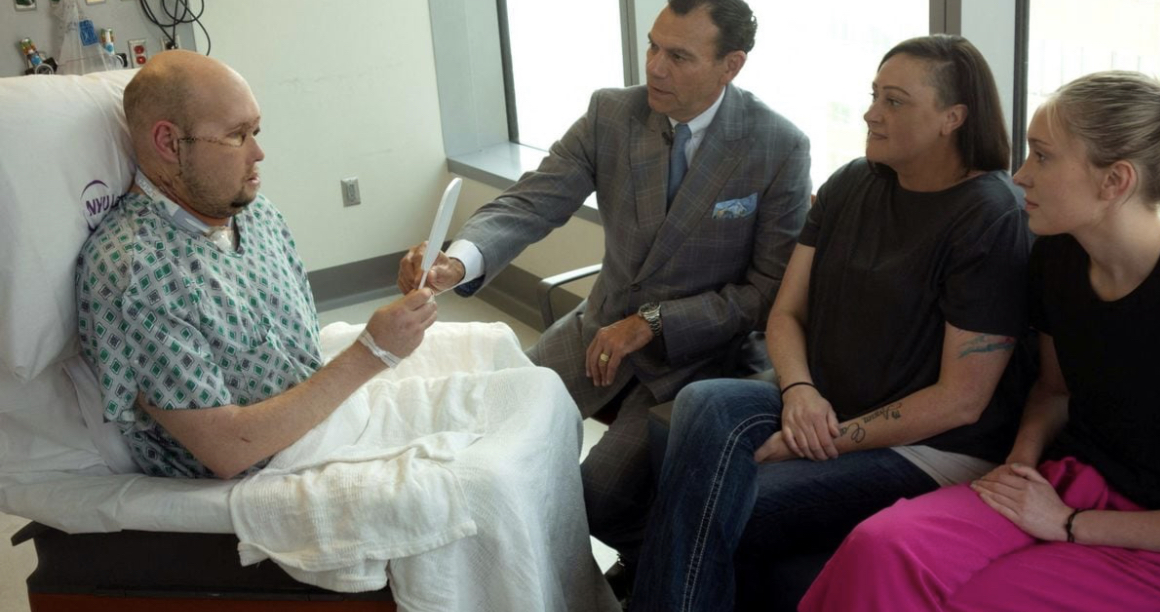Eye transplant as part of a partial face transplant by Dr. Eduardo D. Rodriguez at NYU Langone in New York. NYU Langone Health/Handout via REUTERS
As the years go by, scientists are constantly working to develop innovations and ideas in health and medicine that can save human life and improve its quality.
From new drugs to groundbreaking surgeries, let’s take a quick trip down memory lane to some of 2023’s notable medical breakthroughs.
NEW DRUG SLOWS DOWN PROGRESSION OF DEMENTIA

In July, a new drug, donanemab, was found to slow the progression of Alzheimer’s disease, a type of dementia.
Advertisement
Donanemab, developed by Eli Lilly, works by removing plaques of a protein called amyloid that builds up in the brains of people with Alzheimer’s.
During the drug trials, researchers examined 1,736 people aged 60 to 85 with early-stage Alzheimer’s.
For 18 months, half of them received a monthly infusion of the treatment, and the other half were given a placebo (false drug).
Advertisement
The patients were assessed in groups based on their levels of another Alzheimer’s-associated protein called tau.
It was found that after 76 weeks of treatment, donanemab slowed clinical decline by 35.1 percent in people with early Alzheimer’s whose brain scans showed low or medium levels of tau.
When the results were combined for people who had different levels of this protein, there was a 22.3 percent slow in disease progression.
THERAPIES THAT CAN EDIT GENE OF SICKLE CELL PATIENTS
Advertisement

In December, the United States Food and Drug Administration (FDA) approved Casgevy and Lyfgenia, two milestone gene-based treatments for sickle cell disease.
The treatments were approved for people who are 12 years of age and older with recurrent vaso-occlusive crises.
Casgevy utilises a type of novel genome editing technology — CRISPR/Cas9 — that can accurately edit DNA, while Lyfgenia is a cell-based gene therapy that uses a lentiviral vector for genetic modification.
According to the FDA, Casgevy and Lyfgenia are made from the patient’s blood stem cells, which are modified and given back as a one-time, single-dose infusion as part of a hematopoietic stem cell transplant.
Advertisement
FIRST WHOLE EYE TRANSPLANT
In 2023, surgeons at NYU Langone Health in New York, US, performed the first-ever whole eye transplant on a human.
Advertisement
Before this, doctors had only been able to transplant the cornea, the transparent layer forming the front of the eye.
The recipient of the eye, 46-year-old Aaron James, survived a work-related high-voltage electrical accident that destroyed the left side of the face, nose, mouth and left eye.
Advertisement
The surgical team harvested adult stem cells from the donor’s bone marrow and injected them into the optic nerve during the transplant.
Six months after the surgery, the grafted eye showed important signs of health, including well-functioning blood vessels and a promising-looking retina.
Advertisement
DRUG-FREE KIDNEY TRANSPLANT

In September, Aditi Shankar, an eight-year-old girl, became the first child in the UK to receive a kidney transplant that does not require her to take long-term immunosuppressants.
Immunosuppressants usually need to be taken daily for life, but Shankar stopped taking them a month after her surgery.
Shankar has an extremely rare inherited condition, Schimke’s immuno-osseous dysplasia (SIOD), which weakened her immune system and meant her kidneys were failing.
A bone marrow transplant was first performed using stem cells from her mother to rebuild her immune system, and six months later, she had a kidney transplant, also donated by her mother.
Her immune system accepted the organ, and within weeks of the transplant, Shankar was taken off immunosuppressants.
ARTIFICIAL KIDNEY SUCCESSFULLY TESTED ON PIGS
In August, scientists at the University of California, San Francisco (UCSF), United States, developed a device that mimics the functions of a kidney.
The artificial kidney was made up of human kidney cells, housed in an implantable device called a bioreactor.
It was successfully tested in pigs for one week and found to mimic several important kidney functions.
GENETICALLY MODIFIED PIG KIDNEY SURVIVES ONE MONTH IN THE HUMAN BODY
A pig’s kidney that was transplanted into a human body worked normally, giving hope that this type of operation would save patients’ lives
The experimental surgery was performed with the consent of the family of a man who had been declared brain dead and had donated his body to science.
The researchers at NYU Langone Health said the experiment marks the longest period a genetically engineered pig kidney has functioned in a person.
The man who received the organ was reported to have maintained a beating heart on ventilator support.
SECOND-EVER PIG TO HUMAN HEART TRANSPLANT
In September, surgeons in the US carried out the world’s second transplant of a genetically modified pig’s heart to a human being — one year after the first.
The surgery was carried out on Lawrence Faucette, a 58-year-old patient who had terminal heart disease.
He had been deemed ineligible for a traditional transplant with a human heart due to pre-existing peripheral vascular disease and internal bleeding complications.
The transplant of a pig’s heart was therefore the only option available.
The pig heart had 10 genetic modifications to make it more acceptable to the human immune system.
After the operation, Faucette started breathing on his own, and his heart functioned well without any assistance from supportive devices, but he died six weeks after the experimental procedure.
WHO ENDORSES OXFORD MALARIA VACCINE
In October, the World Health Organisation (WHO) endorsed R21/Matrix-M, a malaria vaccine developed by scientists at Oxford University, to prevent malaria in children.
The R21 vaccine is the second malaria vaccine recommended by WHO, the first being the RTS,S/AS01 vaccine, which received a WHO recommendation in 2021.
According to ongoing clinical trials and other studies, the R21 malaria vaccine showed high efficacy when given just before the high transmission season, good efficacy when given in an age-based schedule, high impact, cost-effectiveness, and safety.
EMBRYO-LIKE STRUCTURES USING HUMAN STEM CELLS
In June, scientists announced that they had used cells to create human embryo-like structures in the laboratory to understand the impact of genetic disorders and the biological causes of recurrent miscarriage.
Two teams led by Magdalena Zernicka-Goetz of Cambridge University and Jacob Hanna of the Weizmann Institute of Science in Israel said they separately developed their embryo models to a stage equivalent to natural embryos about 14 days after fertilisation.
The laboratories used different techniques to create embryo-like structures without needing sperm, an egg, or fertilisation.
The scientists said the motivation for their work was to understand the impact of genetic disorders and the biological causes of recurrent miscarriage.
NEW TREATMENT TO REVERSE PROSTATE CANCER’S RESISTANCE

Photo credit: istockphoto
In October, scientists said they may have discovered how to reverse prostate cancer’s resistance to treatment by blocking the secret messages that they send to hijack healthy myeloid cells, a type of white blood cells.
Some advanced forms of prostate cancer can evade therapy by using the immune system to resist the impact of drugs.
In a trial led by the Institute of Cancer Research (ICR) and the Institute of Oncology Research in Switzerland, scientists recruited 23 patients with advanced prostate cancer who had stopped responding to hormone therapy.
The patients were given a combination of AZD5069, an experimental drug that prevents white blood cells from being dragged inside tumours, and enzalutamide, a hormone therapy commonly used to treat prostate cancer in patients with advanced disease.
Five of the 21 patients responded to the treatment and their tumours shrank by more than 30 percent.
Add a comment






